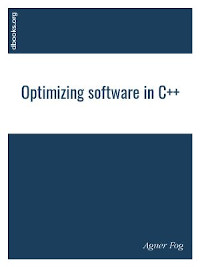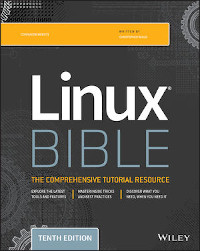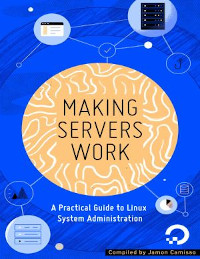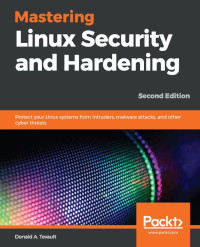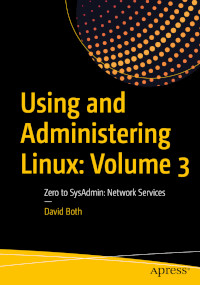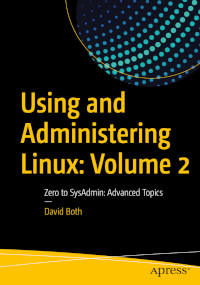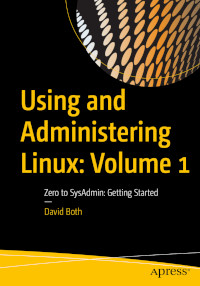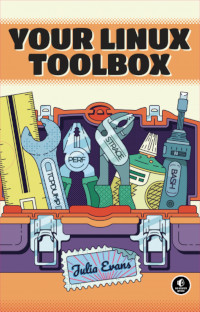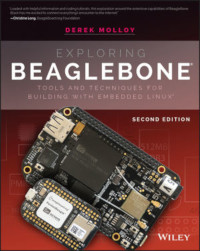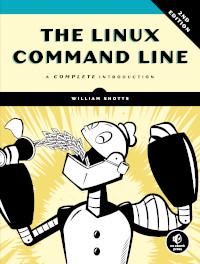Linux eBooks
Optimizing software in C++
This is an optimization manual for advanced C++ programmers. This book are not for beginners. Topics include: - The choice of platform and operating system. - Choice of compiler and framework. - Finding performance bottlenecks. - The efficiency of different C++ constructs. - Multi-core systems. - Parallelization with vector operations. - CPU dispatching. Efficient container class templates. ...
This is an optimization manual for advanced C++ programmers. This book are not for beginners. Topics include: - The choice of platform and operating system. - Choice of compiler and framework. - Finding performance bottlenecks. - The efficiency of different C++ constructs. - Multi-core systems. - Parallelization with vector operations. - CPU dispatching. Efficient container class templates. ...
Linux Bible, 10th Edition
Linux Bible, 10th Edition is the ultimate hands-on Linux user guide, whether you're a true beginner or a more advanced user navigating recent changes. this updated tenth edition covers the latest versions of Red Hat Enterprise Linux (RHEL 8), Fedora 30, and Ubuntu 18.04 LTS. It includes information on cloud computing, with new guidance on containerization, Ansible automation, and Kubernetes and OpenShift. With a focus on RHEL 8, this new edition teaches techniques for managing storage, users, and security, while emphasizing simplified administrative techniques with Cockpit. Written by a Red Hat expert, this book provides the clear explanations and step-by-step instructions that demystify Linux and bring the new features seamlessly into your workflow. This useful guide assumes a base of little or no Linux knowledge, and takes you step by step through what you need to know to get the job done. Get Linux up and running quickly; Master basic ...
Linux Bible, 10th Edition is the ultimate hands-on Linux user guide, whether you're a true beginner or a more advanced user navigating recent changes. this updated tenth edition covers the latest versions of Red Hat Enterprise Linux (RHEL 8), Fedora 30, and Ubuntu 18.04 LTS. It includes information on cloud computing, with new guidance on containerization, Ansible automation, and Kubernetes and OpenShift. With a focus on RHEL 8, this new edition teaches techniques for managing storage, users, and security, while emphasizing simplified administrative techniques with Cockpit. Written by a Red Hat expert, this book provides the clear explanations and step-by-step instructions that demystify Linux and bring the new features seamlessly into your workflow. This useful guide assumes a base of little or no Linux knowledge, and takes you step by step through what you need to know to get the job done. Get Linux up and running quickly; Master basic ...
Making Servers Work
This book highlights practical sysadmin skills, common architectures that you'll encounter, and best practices that apply to automating and running systems at any scale, from one laptop or server to 1,000 or more. It is intended to help orient you within the discipline, and hopefully encourages you to learn more about system administration. ...
This book highlights practical sysadmin skills, common architectures that you'll encounter, and best practices that apply to automating and running systems at any scale, from one laptop or server to 1,000 or more. It is intended to help orient you within the discipline, and hopefully encourages you to learn more about system administration. ...
Mastering Linux Security and Hardening, 2nd Edition
From creating networks and servers to automating the entire working environment, Linux has been extremely popular with system administrators for the last couple of decades. However, security has always been a major concern. With limited resources available in the Linux security domain, this book will be an invaluable guide in helping you get your Linux systems properly secured. Complete with in-depth explanations of essential concepts, practical examples, and self-assessment questions, this book begins by helping you set up a practice lab environment and takes you through the core functionalities of securing Linux. You'll practice various Linux hardening techniques and advance to setting up a locked-down Linux server. As you progress, you will also learn how to create user accounts with appropriate privilege levels, protect sensitive data by setting permissions and encryption, and configure a firewall. The book will help you set up mandatory access ...
From creating networks and servers to automating the entire working environment, Linux has been extremely popular with system administrators for the last couple of decades. However, security has always been a major concern. With limited resources available in the Linux security domain, this book will be an invaluable guide in helping you get your Linux systems properly secured. Complete with in-depth explanations of essential concepts, practical examples, and self-assessment questions, this book begins by helping you set up a practice lab environment and takes you through the core functionalities of securing Linux. You'll practice various Linux hardening techniques and advance to setting up a locked-down Linux server. As you progress, you will also learn how to create user accounts with appropriate privilege levels, protect sensitive data by setting permissions and encryption, and configure a firewall. The book will help you set up mandatory access ...
Using and Administering Linux: Volume 3
Manage complex systems with ease and equip yourself for a new career. This book builds upon the skills you learned in Volumes 1 and 2 of this course and it depends upon the virtual network and virtual machine you created there. However, more experienced Linux users can begin with this volume and download an assigned script that will set up the VM for the start of Volume 3. Instructions with the script will provide specifications for configuration of the virtual network and the virtual machine. Refer to the volume overviews in the book's introduction to select the volume of this course most appropriate for your current skill level. Start by reviewing the administration of Linux servers and install and configure various Linux server services such as DHCP, DNS, NTP, and SSH server that will be used to provide advanced network services. You'll then learn to install and configure servers such as BIND for name services, DHCP for network host configuration, and SSH ...
Manage complex systems with ease and equip yourself for a new career. This book builds upon the skills you learned in Volumes 1 and 2 of this course and it depends upon the virtual network and virtual machine you created there. However, more experienced Linux users can begin with this volume and download an assigned script that will set up the VM for the start of Volume 3. Instructions with the script will provide specifications for configuration of the virtual network and the virtual machine. Refer to the volume overviews in the book's introduction to select the volume of this course most appropriate for your current skill level. Start by reviewing the administration of Linux servers and install and configure various Linux server services such as DHCP, DNS, NTP, and SSH server that will be used to provide advanced network services. You'll then learn to install and configure servers such as BIND for name services, DHCP for network host configuration, and SSH ...
Using and Administering Linux: Volume 2
Experience an in-depth exploration of logical volume management and the use of file managers to manipulate files and directories and the critical concept that, in Linux everything is a file and some fun and interesting uses of the fact that everything is a file. This book builds upon the skills you learned in Volume 1 of this course and it depends upon the virtual network and virtual machine created there. More experienced Linux users can begin with this volume and download the assigned script that will set up the VM for the start of Volume 2. Instructions with the script will provide specifications for configuration of the virtual network and the virtual machine. Refer to the volume overviews in the book's introduction to select the volume of this course most appropriate for your current skill level. You'll see how to manage and monitor running processes, discover the power of the special filesystems, monitor and tune the kernel while it is running - without a rebo ...
Experience an in-depth exploration of logical volume management and the use of file managers to manipulate files and directories and the critical concept that, in Linux everything is a file and some fun and interesting uses of the fact that everything is a file. This book builds upon the skills you learned in Volume 1 of this course and it depends upon the virtual network and virtual machine created there. More experienced Linux users can begin with this volume and download the assigned script that will set up the VM for the start of Volume 2. Instructions with the script will provide specifications for configuration of the virtual network and the virtual machine. Refer to the volume overviews in the book's introduction to select the volume of this course most appropriate for your current skill level. You'll see how to manage and monitor running processes, discover the power of the special filesystems, monitor and tune the kernel while it is running - without a rebo ...
Using and Administering Linux: Volume 1
Become a Linux sysadmin and expert user of Linux even with no previous Linux experience and learn to manage complex systems with ease. Volume 1 of this three volume training course introduces operating systems in general and Linux in particular. It briefly explores the The Linux Philosophy for SysAdmins in preparation for the rest of the course. This book provides you with the tools necessary for mastering user management; installing, updating, and deleting software; and using command line tools to do performance tuning and basic problem determination. You'll begin by creating a virtual network and installing an instance of Fedora - a popular and powerful Linux distribution - on a VirtualBox VM that can be used for all of the experiments on an existing Windows or Linux computer. You'll then move on to the basics of using the Xfce GUI desktop and the many tools Linux provides for working on the command line including virtual con ...
Become a Linux sysadmin and expert user of Linux even with no previous Linux experience and learn to manage complex systems with ease. Volume 1 of this three volume training course introduces operating systems in general and Linux in particular. It briefly explores the The Linux Philosophy for SysAdmins in preparation for the rest of the course. This book provides you with the tools necessary for mastering user management; installing, updating, and deleting software; and using command line tools to do performance tuning and basic problem determination. You'll begin by creating a virtual network and installing an instance of Fedora - a popular and powerful Linux distribution - on a VirtualBox VM that can be used for all of the experiments on an existing Windows or Linux computer. You'll then move on to the basics of using the Xfce GUI desktop and the many tools Linux provides for working on the command line including virtual con ...
Linux Observability with BPF
Build your expertise in the BPF virtual machine in the Linux kernel with this practical guide for systems engineers. You'll not only dive into the BPF program lifecycle but also learn to write applications that observe and modify the kernel's behavior; inject code to monitor, trace, and securely observe events in the kernel; and more. Authors David Calavera and Lorenzo Fontana help you harness the power of BPF to make any computing system more observable. Familiarize yourself with the essential concepts you'll use on a day-to-day basis and augment your knowledge about performance optimization, networking, and security. Then see how it all comes together with code examples in C, Go, and Python. Write applications that use BPF to observe and modify the Linux kernel's behavior on demand; Inject code to monitor, trace, and observe events in the kernel in a secure way - no need to recompile the kernel or reboot the system; Explore code examples in C, Go, and Python; Gain ...
Build your expertise in the BPF virtual machine in the Linux kernel with this practical guide for systems engineers. You'll not only dive into the BPF program lifecycle but also learn to write applications that observe and modify the kernel's behavior; inject code to monitor, trace, and securely observe events in the kernel; and more. Authors David Calavera and Lorenzo Fontana help you harness the power of BPF to make any computing system more observable. Familiarize yourself with the essential concepts you'll use on a day-to-day basis and augment your knowledge about performance optimization, networking, and security. Then see how it all comes together with code examples in C, Go, and Python. Write applications that use BPF to observe and modify the Linux kernel's behavior on demand; Inject code to monitor, trace, and observe events in the kernel in a secure way - no need to recompile the kernel or reboot the system; Explore code examples in C, Go, and Python; Gain ...
Your Linux Toolbox
Get the most out of your Linux system using tools you already have! These illustrated zines by Julia Evans will teach you how simple it can be to tame the powerful beast called Linux. And for the first time, her tips and tricks are together in one place. Find out what your programs are doing and why. Understand how your system's parts talk to each other and what to do when they bicker. And see how a cat GIF travels from a distant server to your very own screen. Includes 7 zines: So You Want to Be a Wizard; Bite-Size Linux! Networking, ACK! Let's Learn tcpdump! Linux Debugging Tools You'll Love; Spying on Your Programs with strace; Profiling & Tracing with perf. ...
Get the most out of your Linux system using tools you already have! These illustrated zines by Julia Evans will teach you how simple it can be to tame the powerful beast called Linux. And for the first time, her tips and tricks are together in one place. Find out what your programs are doing and why. Understand how your system's parts talk to each other and what to do when they bicker. And see how a cat GIF travels from a distant server to your very own screen. Includes 7 zines: So You Want to Be a Wizard; Bite-Size Linux! Networking, ACK! Let's Learn tcpdump! Linux Debugging Tools You'll Love; Spying on Your Programs with strace; Profiling & Tracing with perf. ...
Exploring BeagleBone, 2nd Edition
Exploring BeagleBone is a hands-on guide to bringing gadgets, gizmos, and robots to life using the popular BeagleBone embedded Linux platform. Comprehensive content and deep detail provide more than just a BeagleBone instruction manual-you'll also learn the underlying engineering techniques that will allow you to create your own projects. The book begins with a foundational primer on essential skills, and then gradually moves into communication, control, and advanced applications using C/C++, allowing you to learn at your own pace. In addition, the book's companion website features instructional videos, source code, discussion forums, and more, to ensure that you have everything you need. The BeagleBone's small size, high performance, low cost, and extreme adaptability have made it a favorite development platform, and the Linux software base allows for complex yet flexible functionality. The BeagleBone has applications in smart buildings, robot control, environmental s ...
Exploring BeagleBone is a hands-on guide to bringing gadgets, gizmos, and robots to life using the popular BeagleBone embedded Linux platform. Comprehensive content and deep detail provide more than just a BeagleBone instruction manual-you'll also learn the underlying engineering techniques that will allow you to create your own projects. The book begins with a foundational primer on essential skills, and then gradually moves into communication, control, and advanced applications using C/C++, allowing you to learn at your own pace. In addition, the book's companion website features instructional videos, source code, discussion forums, and more, to ensure that you have everything you need. The BeagleBone's small size, high performance, low cost, and extreme adaptability have made it a favorite development platform, and the Linux software base allows for complex yet flexible functionality. The BeagleBone has applications in smart buildings, robot control, environmental s ...
The Linux Command Line, 2nd Edition
The Linux Command Line takes you from your very first terminal keystrokes to writing full programs in Bash, the most popular Linux shell (or command line). Along the way you'll learn the timeless skills handed down by generations of experienced, mouse-shunning gurus: file navigation, environment configuration, command chaining, pattern matching with regular expressions, and more. In addition to that practical knowledge, author William Shotts reveals the philosophy behind these tools and the rich heritage that your desktop Linux machine has inherited from Unix supercomputers of yore. As you make your way through the book's short, easily-digestible chapters, you'll learn how to: Create and delete files, directories, and symlinks; Administer your system, including networking, package installation, and process management; Use standard input and output, redirection, and pipelines; Edit files with Vi, the world's most popular text editor; Write shell scripts to aut ...
The Linux Command Line takes you from your very first terminal keystrokes to writing full programs in Bash, the most popular Linux shell (or command line). Along the way you'll learn the timeless skills handed down by generations of experienced, mouse-shunning gurus: file navigation, environment configuration, command chaining, pattern matching with regular expressions, and more. In addition to that practical knowledge, author William Shotts reveals the philosophy behind these tools and the rich heritage that your desktop Linux machine has inherited from Unix supercomputers of yore. As you make your way through the book's short, easily-digestible chapters, you'll learn how to: Create and delete files, directories, and symlinks; Administer your system, including networking, package installation, and process management; Use standard input and output, redirection, and pipelines; Edit files with Vi, the world's most popular text editor; Write shell scripts to aut ...
